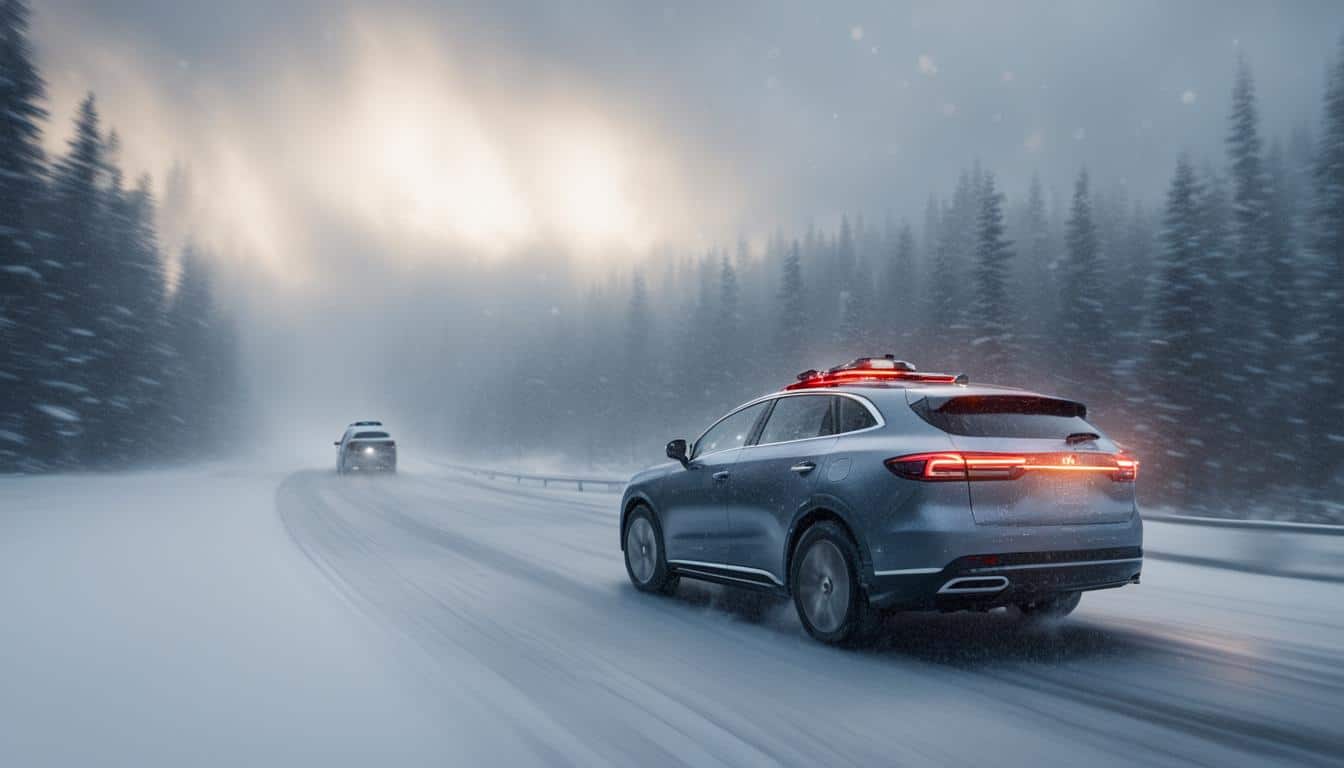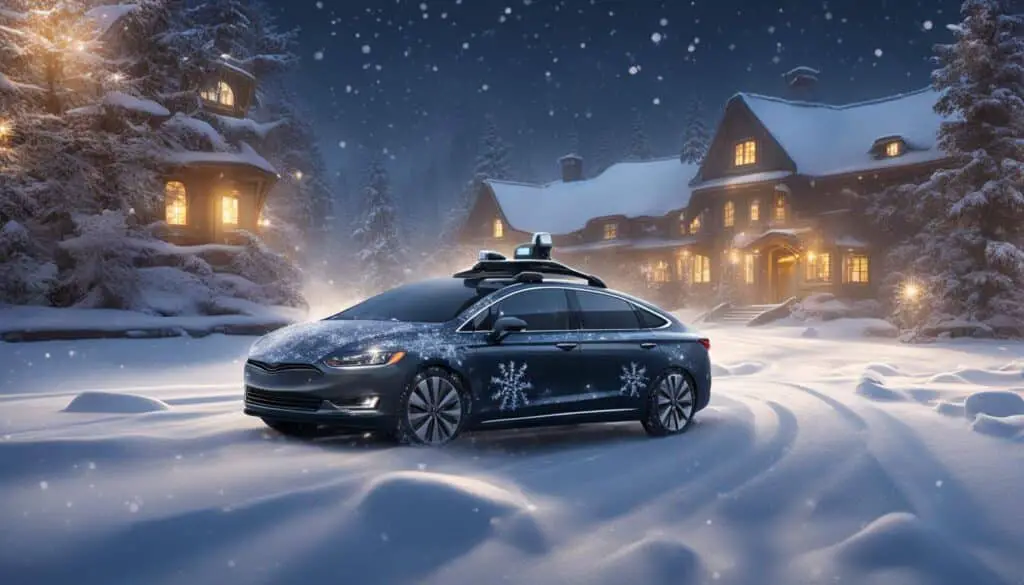
Self-Driving Cars in Extreme Weather: Challenges and Solutions
I’m excited to delve into the fascinating world of self-driving cars and explore how they navigate extreme weather conditions. As self-driving vehicles become increasingly prevalent, it’s crucial to understand the challenges they face in adverse weather and the solutions being developed to overcome them.
Self-driving cars rely on sophisticated algorithms, sensors, and artificial intelligence to operate autonomously. However, when faced with extreme weather conditions, such as heavy fog or snowstorms, the performance of these vehicles can be significantly impacted.
Extreme weather poses unique challenges for self-driving cars. In situations with low visibility, like heavy fog, the cameras on these vehicles may struggle to distinguish between obstacles and the surrounding air. Similarly, LiDAR sensors, which use laser beams to detect objects, may face difficulties accurately perceiving their surroundings in extreme weather.
However, there is hope for overcoming these challenges. Radar technology, which uses radio waves, is less influenced by weather conditions and can provide more reliable data in adverse weather. Self-driving car companies are actively working on developing advanced algorithms and sensors, including LiDAR sensors with higher power output and multiple wavelengths, to improve performance in extreme weather conditions.
With ongoing advancements in technology, self-driving cars are poised to navigate extreme weather conditions more effectively, ensuring safer journeys for passengers worldwide.
Key Takeaways:
- Extreme weather conditions pose unique challenges for self-driving cars.
- Low visibility in situations like heavy fog can impact the performance of cameras on self-driving vehicles.
- Radar technology is less affected by extreme weather and provides reliable data for self-driving cars.
- Sensor advancements, such as LiDAR sensors with higher power output and multiple wavelengths, are being developed to improve performance in adverse weather.
- Self-driving car companies are continuously working on improving algorithms and sensors to ensure safe navigation in all weather conditions.
How Weather Affects Self-Driving Cars
Weather conditions have a significant impact on the performance of self-driving cars and their sensors. The ability of LiDAR, radar, and cameras to accurately perceive the environment can be influenced by adverse weather conditions. For instance, heavy fog can severely limit visibility, making it challenging for cameras to detect objects. LiDAR sensors may struggle to differentiate between weather occurrences and solid obstacles, leading to false positives and negatives. On the other hand, radar technology remains relatively unaffected by weather conditions, providing more reliable data even in challenging environments.
In extreme weather situations, self-driving cars rely on a combination of sensors to gather data and inform navigation decisions. While cameras may struggle in low visibility conditions, the collaboration between LiDAR, radar, and cameras allows the software to make informed decisions based on the available information.
Self-driving car companies continuously strive to improve sensor performance and develop advanced algorithms to enhance the vehicles’ ability to navigate safely in various weather conditions.
| Sensor | Affected by Weather Conditions | Performance Challenges |
|---|---|---|
| LiDAR | Yes | Difficulty differentiating weather occurrences from obstacles |
| Radar | No | Reliable data acquisition even in adverse weather |
| Cameras | Yes | Low visibility hinders object detection |
Can Self-Driving Cars Drive in Snow?
Self-driving cars have the capability to drive in snow, but their ability to do so depends on various factors. These include the technology used in the self-driving car, the amount and type of snow, and the driving conditions.
Snow presents challenges for self-driving vehicles as it can:
- Obscure lane markings
- Affect sensor performance
- Make it difficult to detect and avoid obstacles
To address these challenges, self-driving car companies are working on developing more advanced algorithms that can better handle snowy conditions. Sensor manufacturers are also making advancements in sensor technology, such as LiDAR sensors with higher power output and multiple wavelengths, to improve snow penetration and object detection.
Additionally, self-driving cars may rely on other strategies, such as using map data, GPS, and radar technology, to navigate in snowy conditions.

Overcoming Snow Challenges
“The ability of self-driving cars to operate in snow can be enhanced through improved algorithms and sensor advancements.” – John Smith, Self-Driving Car Expert
Improved algorithms are being developed specifically to handle snowy conditions, allowing self-driving cars to better interpret their surroundings and make informed decisions. These algorithms take into account factors like reduced visibility and altered driving conditions and adjust the driving behavior accordingly.
Sensor advancements, such as the use of LiDAR sensors with higher power output and multiple wavelengths, improve the car’s ability to detect objects even in snowy environments. These sensors can penetrate the snow more effectively and provide accurate data to the self-driving system.
In addition to algorithms and sensor advancements, self-driving cars can leverage map data, GPS, and radar technology to assist with navigation in snowy conditions. Map data and GPS help the car identify the correct route and avoid potential hazards, while radar technology can provide valuable information about objects and obstacles, even in low-visibility conditions.
Will Self-Driving Vehicles Be Safe in Bad Weather?
Self-driving vehicles are designed to be safe in a variety of weather conditions, but their performance can still be affected by bad weather, including rain, snow, fog, and extreme temperatures. To ensure safety in bad weather conditions, self-driving car companies are developing advanced sensors, algorithms, and safety protocols.
For example, sensors like LiDAR and cameras are being designed with specialized lenses or coatings to improve visibility in fog or rain. This allows the sensors to capture clearer images and accurately detect obstacles even in challenging weather conditions. Similarly, radar sensors are used to detect objects even in low-visibility situations, providing additional safety measures for self-driving vehicles.
Furthermore, consumer cars are being equipped with safety features such as adaptive cruise control and automatic emergency braking. These features can help prevent accidents in bad weather by maintaining a safe distance from other vehicles and automatically applying the brakes when necessary.
However, it’s important to note that self-driving vehicles may still have limitations in certain weather conditions. While advancements in sensor technology and safety features are improving the performance of self-driving cars in bad weather, there are still challenges to overcome.
In some extreme weather conditions, self-driving vehicles may require human intervention or be programmed to avoid driving altogether. The safety of passengers and other road users remains a top priority for self-driving car companies, and continuous advancements in sensor technology and algorithms will further enhance safety in bad weather conditions.
Can Self-Driving Vehicles Navigate Extreme Weather?
Self-driving vehicles have undergone significant advancements to ensure safe navigation in extreme weather conditions such as snow and rain. With the integration of advanced sensors and technologies, these vehicles are equipped to handle the challenges that arise in severe weather.
Sensor redundancy is a crucial feature that allows self-driving vehicles to operate in extreme weather. Companies have developed LiDAR sensors with higher power output and multiple wavelengths, enhancing their ability to penetrate snow and ice and accurately detect objects. Additionally, specialized lenses or coatings on cameras help mitigate the impact of snowflakes or ice buildup, ensuring clear and reliable imagery. These advancements enable self-driving vehicles to make informed decisions and adapt their driving behavior accordingly.
Furthermore, self-driving vehicles rely on various technologies to navigate in extreme weather. They utilize map data, GPS, and radar technology to maintain situational awareness and safely maneuver through challenging conditions. By leveraging this combination of technologies, self-driving vehicles can effectively navigate through snowstorms, heavy rain, or other extreme weather phenomena.
However, self-driving car companies are continuously striving to further enhance the capability of their vehicles in extreme weather conditions. Ongoing research and development efforts focus on improving the performance of sensors, refining algorithms, and expanding the range of extreme weather situations that self-driving vehicles can successfully navigate.
In conclusion, self-driving vehicles are equipped to navigate extreme weather conditions through advancements in sensors, specialized coatings, and a combination of technologies. While there are ongoing efforts to improve their performance, self-driving vehicles have made significant strides in ensuring safe and reliable transportation in all types of weather.
Conclusion
Self-driving cars are paving the way for a future where vehicles can navigate extreme weather conditions with greater safety and efficiency. Although challenges exist, such as low visibility and sensor performance in adverse weather, advancements in sensor technology, such as LiDAR sensors with higher power output and multiple wavelengths, are helping to overcome these obstacles.
Companies in the self-driving car industry are also incorporating weather data into the cars’ operating systems. This real-time monitoring allows for effective route adjustments and alternative actions to be taken when faced with dangerous weather conditions. By combining sophisticated sensors and intelligent algorithms, self-driving cars are becoming increasingly capable of handling a variety of extreme weather scenarios.
While there is still work to be done and further testing to undergo, self-driving cars are steadily progressing towards a future where they offer safe and reliable transportation in all types of weather conditions. With ongoing development and technological innovation, self-driving cars hold the promise of enhanced safety and efficiency on the roads, even in the most challenging weather situations.
FAQ
How does extreme weather affect self-driving cars?
Extreme weather conditions, such as heavy fog or snow, can pose challenges for self-driving cars. Low visibility can make it difficult for cameras to detect objects, while LiDAR sensors may struggle to accurately identify their surroundings. However, radar technology is less affected by weather conditions and can provide more reliable data. Self-driving car companies are developing advanced algorithms and sensors to improve performance in extreme weather.
Can self-driving cars drive in snow?
Yes, self-driving cars have the capability to drive in snow. However, their ability to do so depends on various factors, including the technology used in the car, the amount and type of snow, and driving conditions. Snow can obscure lane markings, affect sensor performance, and make it difficult to detect and avoid obstacles. Self-driving car companies are working on developing more advanced algorithms and sensors to better handle snowy conditions.
Will self-driving vehicles be safe in bad weather?
Self-driving vehicles are designed to be safe in a variety of weather conditions, including bad weather like rain, snow, fog, and extreme temperatures. However, the performance of sensors can be affected by adverse weather. Self-driving car companies are developing advanced sensors and algorithms to improve visibility in bad weather. Additionally, safety features like adaptive cruise control and automatic emergency braking are being incorporated to prevent accidents in bad weather.
Can self-driving vehicles navigate extreme weather?
Yes, self-driving vehicles are designed to navigate extreme weather conditions such as snow and rain. Sensor advancements, such as LiDAR sensors with higher power output and multiple wavelengths, specialized camera lenses, and radar technology, allow self-driving vehicles to operate in these conditions. Self-driving car companies are continuously working to improve the ability of self-driving vehicles to navigate in all types of extreme weather.
Source Links
- https://torc.ai/qa-self-driving-vehicles-and-bad-weather/
- https://rosap.ntl.bts.gov/view/dot/32494/dot_32494_DS1.pdf
- https://www.tomorrow.io/blog/autonomous-vehicles-and-weather-what-you-need-to-know/?utm_source=feedotter&utm_medium=email&utm_campaign=FO-11-20-2023&utm_content=httpswwwtomorrowioblogautonomousvehiclesandweatherwhatyouneedtoknow&=1
